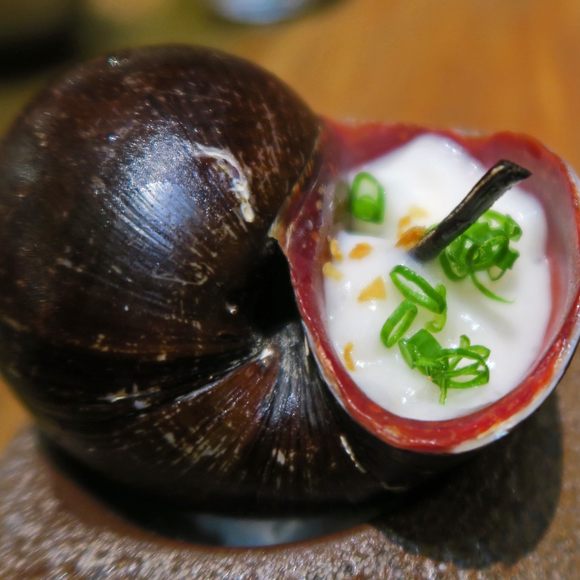Meats & Animal Products
Churo Snails
Lima chefs love to experiment with this large Amazon river dweller.
In the open-air Amazonian markets of Peruvian cities like Yurimaguas and Iquitos, it’s not unusual to see large containers full of giant aquatic snails. Elsewhere in the world, these big brown gastropods, the largest of which can grow to six inches in length, would likely end up in aquariums. Here, however, they are destined for the pot.
The churo snail, also known as Pomacea maculata, has long been a source of protein among indigenous Amazonian tribes. Churos live throughout the vast Loreto region of northeastern Peru, inhabiting the river basins of the Amazon, Marañón, Napo, and Ucayali rivers. They can also be found in Amazonian regions of Brazil and Venezuela.
When the rivers are high, snail-harvesters paddle their way through the flooded jungle to pluck churos from the trees like fruit. They take only the largest snails, leaving the rest to develop. Once harvested, the giant snails are placed in buckets of water for at least 24 hours, giving them a chance to purge and clean themselves. Just to make sure they’re fully clean, chefs will also boil them before use.
Classic snail dishes in the Peruvian Amazon include caldo de churros (churo broth) and snail stew, both of which are typically bolstered by green plantains and flavored with garlic and salt. Some locals also eat them as a simple appetizer, garnished with finely chopped onion, cilantro, and lime juice. You can also buy canned giant snails in brine.
Among some indigenous communities of Loreto, especially those that are farther from the city and have maintained older traditions, churos are prized for their aphrodisiac and medicinal properties, including as a cure for hangovers. They are also a rich source of protein and help fight anemia.
Meanwhile, 600 miles away on Peru’s desert coastline, the same giant Amazonian snails have begun slowly sliding onto the plates of the country’s most upscale restaurants. In Lima, Pedro Miguel Schiaffino, owner of ámaZ and a self-professed student of Amazonian ingredients, was one of the first chefs to add churos to his menu. In the trendy Miraflores district of Lima, Schiaffino serves his churos pishpirones in a chorizo and tapioca sauce. It’s a far cry from Peru’s jungle markets, but a fine way to introduce this often challenging ingredient to a wider audience.
Written By
 Tony Dunnell
Tony Dunnell
Sources
- www.nytimes.com/2013/04/07/travel/restaurant-report-amaz-in-lima-peru.html
- www.fondazioneslowfood.com/en/ark-of-taste-slow-food/churo-snail/
- repositorio.unsm.edu.pe/handle/11458/56?show=full
- www.iiap.org.pe/wfr_Descarga.aspx?id=Tjixq+gXvkA/UCC6a3Avdw==&tipo=SNrz4CY7n79ZfATctl9apg==
- www.newperuvian.com/weird-foods-in-peru-for-adventurous-eaters/
- amaz.com.pe/carta_piqueos.php
















